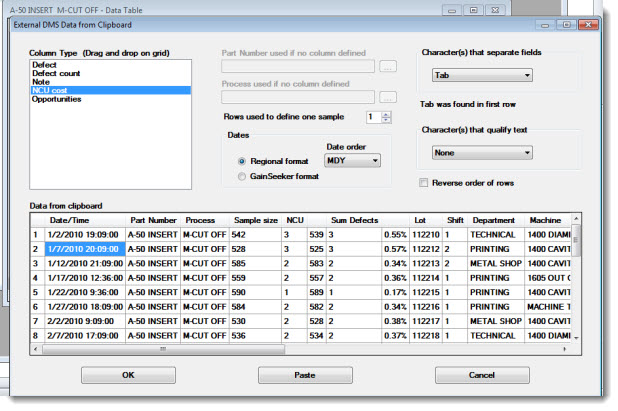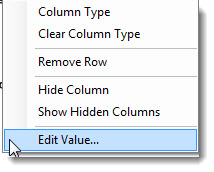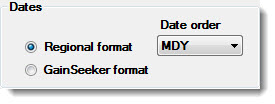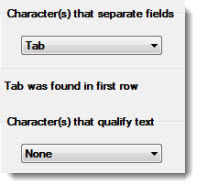
From the GainSeeker Charts module, you can use the Windows clipboard to Copy and Paste external data for GainSeeker analysis.
Several steps are needed to correctly read data from the clipboard:
Use the application best suited to your external data source to view a data set and copy it to the Windows clipboard.
Whatever the source, this data must be limited to a single standard. For SPC data, this is one combination of Part Number + characteristic being measured. For DMS, this is one combination of Part Number + Process.
Use Microsoft Excel to open a spreadsheet of numeric and text data. Highlight the cells to be analyzed, then click the Excel Edit menu and select Copy.
–or–
Use the Windows Notepad to open a text file that contains numeric and text data separated by commas or tabs. Highlight the rows of data to analyze, then click the Notepad Edit menu and select Copy.
–or–
Use GainSeeker to create a Data Table for one standard. Then right-click that Data Table, point to Send To, and choose Clipboard.
In the GainSeeker Charts module, click the File menu. Point to External Data and then click Copied SPC or Copied DMS.

The data you have copied will display on the External (SPC or DMS ) Data from Clipboard window:

Verify that the data to be analyzed is correctly displayed in the Data from clipboard list.

If the data is not correctly displayed, use one or more of the following tools to correct the data:
If the data displayed on this screen is not the data you want to analyze, you can overwrite it with new data from the Clipboard. For more information, see Pasting new data from the Clipboard.
Based on the data you copied to the clipboard, GainSeeker attempts to automatically determine where columns are divided and how text values are formatted. If that determination is not correct, you can configure these settings to match your data. For more information, see Dividing columns and formatting text values within this topic.
If the Data from clipboard list on the External SPC (or DMS) Data from Clipboard dialog displays any rows that should not be analyzed, such as header information, you should remove those rows from the grid. For more information, see Removing unwanted rows
If an individual value in the Data from clipboard is incorrect, you can manually change that value. Right-click on the cell to be changed, and then click Edit Value... on the menu that displays:

The Enter Value dialog opens.
Enter the correct value in the text field and then click OK.

If the Data from clipboard box displays any columns that should not be analyzed, you can hide these columns from display:
Right-click each column that you do not want analyzed, and then click Hide Column on the menu that displays. To display hidden columns, right-click anywhere on the grid, and then click Show Hidden Columns on the menu that displays.
For GainSeeker to correctly analyze your data, you must identify the type of information in each relevant column. You must specify at least one Data column. For more information, see Specifying column types
If any value in a Data column is missing, you should enter the asterisk character ( * ) for the missing value or leave that value blank. Any other non-numeric values in this column will not allow this subgroup to be charted correctly.
Set the ![]() to the number of data rows that should be combined into one subgroup. For more information, see Number of rows per subgroup
to the number of data rows that should be combined into one subgroup. For more information, see Number of rows per subgroup
If one of the columns you specified is the Date/Time column, GainSeeker attempts to automatically determine the order of month, day, and year in the specified dates.

If the selected Regional format does not match the date/time stamps in your data, select the correct format from the Date order drop-down list. Or if your date/time stamps are formatted in the GainSeeker format of "yyyymmddhhnnssxx," select this option.
If you have not specified a column for Part Number, you must use the Part Number used if no column defined box to designate which standard to use. You may either choose a standard that already exists by clicking the ellipsis button and selecting an available listed standard, or you specify a name for a new temporary standard by entering it in the text field:

For more information on choosing a standard in the list, see Finding and selecting SPC standards.
After verifying your settings, click OK to proceed with data analysis. For instructions on analyzing this data, see Analyzing external data
Based on the data you copied to the Clipboard, GainSeeker automatically attempts to determine where columns are divided and how text values are formatted. If the information that GainSeeker displays is not correct, you can configure these settings to match your data.
Characters that separate fields
Data copied from many data files and tables will use special characters—most commonly, tabs, commas, or spaces—to mark where one column ends and the next begins. For example, data copied from a spreadsheet in Microsoft Excel uses tab characters to separate columns.
It can be difficult to distinguish whether white space in the Data from clipboard box comes from spaces or tabs, a note on the right side of the External (SPC or DMS) Data from Clipboard indicates whether tab characters were detected in the first row of data.

Characters that qualify text
Some files and tables will use characters such as quotation marks (") to mark text fields while numeric fields simply contain a numeric value.